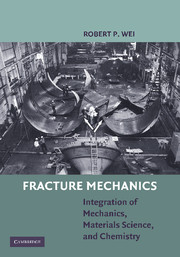Book contents
- Frontmatter
- Contents
- Preface
- Acknowledgments
- 1 Introduction
- 2 Physical Basis of Fracture Mechanics
- 3 Stress Analysis of Cracks
- 4 Experimental Determination of Fracture Toughness
- 5 Fracture Considerations for Design (Safety)
- 6 Subcritical Crack Growth: Creep-Controlled Crack Growth
- 7 Subcritical Crack Growth: Stress Corrosion Cracking and Fatigue Crack Growth (Phenomenology)
- 8 Subcritical Crack Growth: Environmentally Enhanced Crack Growth under Sustained Loads (or Stress Corrosion Cracking)
- 9 Subcritical Crack Growth: Environmentally Assisted Fatigue Crack Growth (or Corrosion Fatigue)
- 10 Science-Based Probability Modeling and Life Cycle Engineering and Management
- APPENDIX: Publications by R. P. Wei and Colleagues
- References
4 - Experimental Determination of Fracture Toughness
Published online by Cambridge University Press: 05 June 2012
- Frontmatter
- Contents
- Preface
- Acknowledgments
- 1 Introduction
- 2 Physical Basis of Fracture Mechanics
- 3 Stress Analysis of Cracks
- 4 Experimental Determination of Fracture Toughness
- 5 Fracture Considerations for Design (Safety)
- 6 Subcritical Crack Growth: Creep-Controlled Crack Growth
- 7 Subcritical Crack Growth: Stress Corrosion Cracking and Fatigue Crack Growth (Phenomenology)
- 8 Subcritical Crack Growth: Environmentally Enhanced Crack Growth under Sustained Loads (or Stress Corrosion Cracking)
- 9 Subcritical Crack Growth: Environmentally Assisted Fatigue Crack Growth (or Corrosion Fatigue)
- 10 Science-Based Probability Modeling and Life Cycle Engineering and Management
- APPENDIX: Publications by R. P. Wei and Colleagues
- References
Summary
In the preceeding chapters, the physical basis and analytical framework, based on linear elasticity, for addressing the issue of unstable or sudden fracture of engineering materials were presented. The driving force for fracture, or crack growth, is characterized in terms of the strain energy release rate G, or the crack-tip stress intensity factor K defined through the linear elasticity analysis. Crack growth instability, or sudden fracture, would occur when these parameters reached their “critical” values. These values represent the material property conjugate to the crack-driving forces (G or K), i.e., the fracture toughness. With the present state of understanding, fracture toughness cannot be calculated based on other mechanical properties and must be measured experimentally. Because the underlying analytical framework is that of linear elasticity, and the materials of engineering interest are expected to undergo nonelastic deformations at the crack tip, measurements of fracture toughness and the utilization of this information in design must conform to conditions under which linear elastic analysis can serve as a “good” approximation. In this chapter, the experimental procedures for determining fracture toughness are described. The analytical and empirical bases for the design of specimens and the interpretation of test records are summarized. Before discussing the methods for measuring fracture toughness, it is important to first examine the consequences of plastic deformation at the crack tip in relation to fracture.
- Type
- Chapter
- Information
- Fracture MechanicsIntegration of Mechanics, Materials Science and Chemistry, pp. 50 - 71Publisher: Cambridge University PressPrint publication year: 2010



